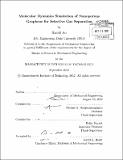Molecular dynamics simulation of nanoporous graphene for selective gas separation
Author(s)
Au, Harold (Harold S.)
DownloadFull printable version (5.737Mb)
Other Contributors
Massachusetts Institute of Technology. Dept. of Mechanical Engineering.
Advisor
Nicolas G. Hadjiconstantinou and Rohit Karnik.
Terms of use
Metadata
Show full item recordAbstract
Graphene with sub-nanometer sized pores has the potential to act as a filter for gas separation with considerable efficiency gains compared to traditional technologies. Nanoporous graphene membranes are expected to yield high selectivity through molecular size exclusion effects, while achieving high permeability due to the very small thickness of graphene. In this thesis, we model the separation of gas components from a mixture using a graphene sheet with engineered pores of different sizes. We employ molecular dynamics simulations to calculate a large number of molecular trajectories, and thus obtain low-statistical-uncertainty estimates of transport rates through the membrane. Simulations are performed on two different gas mixtures - a helium-sulfur hexafluoride mixture, for which the large difference in molecular size lends itself to a size-based separation approach, and a hydrogen-methane mixture, which is relevant to natural gas processing. Our simulations show that graphene membranes with large pores are permeable to both gases in the mixture. As pore sizes are reduced, we observe a greater decrease in the permeability of the larger species that results in a molecular size exclusion effect for a range of pore sizes that are still permeable to the smaller species. This indicates that a pore size can be determined that achieves high selectivity in gas separation, while exhibiting high permeability for the desired gas species. We expect this work to form the basis for the design of an energy-efficient graphene-based gas separation device. The simulation-based approach described here can be very useful for guiding experimental efforts which are currently limited by the difficulty associated with creating pores of a specific size in otherwise pristine graphene.
Description
Thesis (S.M.)--Massachusetts Institute of Technology, Dept. of Mechanical Engineering, 2012. Cataloged from PDF version of thesis. Includes bibliographical references (p. 71-76).
Date issued
2012Department
Massachusetts Institute of Technology. Department of Mechanical EngineeringPublisher
Massachusetts Institute of Technology
Keywords
Mechanical Engineering.